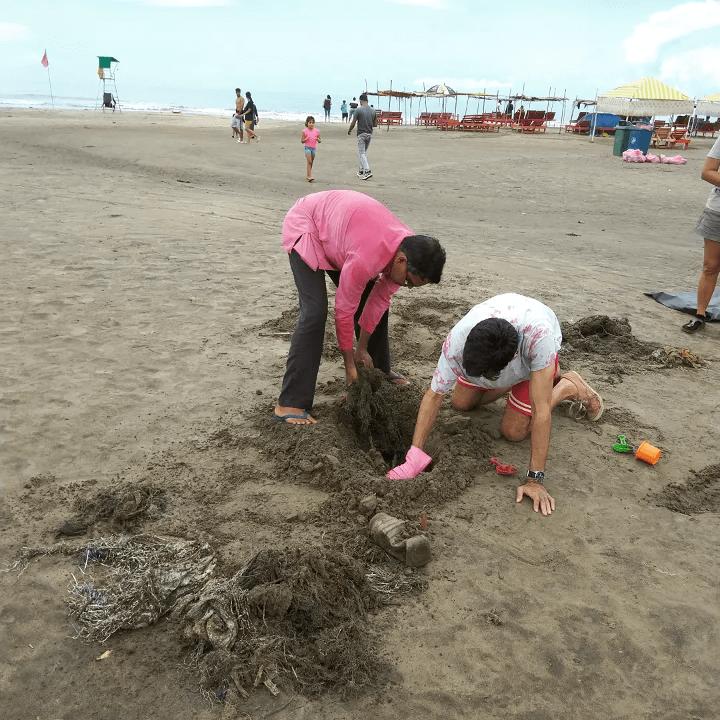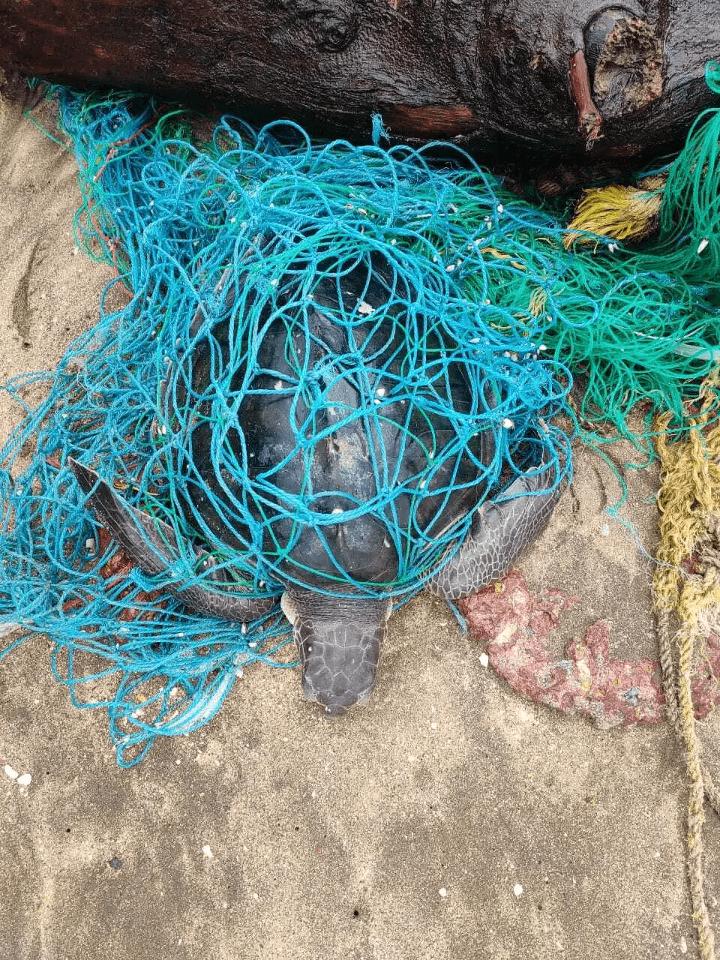WHAT ARE GHOST NETS?
When we hear the term ‘Ghost Nets’ we automatically think of something eerie or haunted. The truth is that these fishing nets which have been abandoned, lost, or discarded (ALD), at sea, on beaches, or in harbors are truly eerie and as good as being haunted.
These nets are a major contributor to the bigger problem of ghost gear, which refers to all types of fishing gear, including nets, lines, traps, etc. that are no longer actively managed by fishers or fisheries. Ghost gear, specifically ghost nets are causing major harm to various marine life forms. Just because the nets are no longer being used by fishers, doesn’t mean these nets don’t function as nets in the sea. They continue ‘unintentional fishing’ which is often called ‘ghost fishing’. These nets also get entangled and are ingested by unsuspecting marine animals.
Each year, ghost gear is responsible for trapping and killing a significant number of marine animals, such as sharks, rays, bony fish, sea turtles, dolphins, whales, crustaceans as well as sea birds. These nets affect coral reefs too by smothering coral reefs, breaking corals, exposing them to disease, and even blocking the reefs from needed sunlight.
WHY DOES ‘GHOST GEAR’ EXIST??
Up till the 1960s, fishing nets were made from rope, however, since then the nets started being made from nylon as it was much stronger and cheaper than rope. Nylon is made out of plastic and just like all other plastic products it does not decompose. That means that these ghost nets continue to cause havoc and damage to the marine environment for many years. Because of this, hundreds of millions of marine animals are killed or injured every year due to fishing nets pollution.
Ghost gear is an unintended by-product of fishing and occurs when the fisher loses all operational control of the equipment. Here are some reasons why fishing gear may become abandoned, lost, or intentionally discarded:
- Poor weather conditions
- Poor access to disposal or recycling facilities
- Poor gear maintenance
- High cost of retrieval
- Conflict between fisheries & vandalism
- Abandonment during illegal fishing activities
- Catch overload causes the net to break in the deep ocean and cannot be retrieved.
WHY IS IT IMPORTANT TO DEAL WITH THIS ISSUE?
Ghost gear is not an issue concerning a single country or a continent. Rather it is a global issue that occurs everywhere in the world wherever fishing occurs. Ocean currents can cause ghost gear to drift far from its origin and cross countless borders thus disrupting the marine environment and affecting marine animals way beyond official fishing territories. As a result, the gear can often end up all over the world on beaches, coral reefs, in the deep sea, and in the open ocean as large conglomerates.

Even though due to its cryptic and transboundary nature which makes an assessment of the impact of ghost gear on the environment extremely difficult, it is still widely recognized as a major source of mortality for many marine organisms, and causing a major negative impact on the marine environment.
Some of the major damage caused by Ghost Nets include:
- Entanglement in Ghost Nets
Ghost nets cause entanglement of all kinds of marine life from small crustaceans to larger organisms such as sharks, turtles, whales, dolphins, etc. What is worse is that these animals die a slow death as they remain stuck in nets for weeks, months, or even years. Those that need to come up for air will die by drowning and the others die of starvation, exhaustion, or predation.
Entanglements are not the only problem caused by ghost fishing. Marine animals often ingest hooks, lines, and nets, causing an array of problems such as perforation of the gastrointestinal tract, obstruction, sepsis, toxicity, and starvation.
- Smothering of Coral Reefs
Ghost nets often sink to the seafloor and can be found in sensitive habitats, such as coral reefs. Here, the ghost nets can damage coral and even block access to necessary sunlight by smothering the reef, thereby damaging the sensitive ecosystem.
- Adds to the Plastic Crisis
As we already read earlier since the 1960’s a major switch from rope nets to a plastic alternative of nylon nets is added to the issue of ghost fishing. Ghost nets are a major contributor to the ocean plastics crisis. According to a 2018 study in Scientific Reports, ghost nets make up at least 46% of the Great Pacific Garbage Patch. Those abandoned fishing lines and nets that do break down never go away; they just become smaller pieces of plastic. Marine animals mistake this microplastic for food and eat it, which can harm internal organs, keep them from eating, and expose them to toxic chemicals. The issue of microplastics entering into our food chain and drinking water is a major concern for the welfare of human beings as well
- Invasive Species Dispersal
Ghost nets get carried by the current and hence can travel for thousands of miles and occupy a variety of different habitats. Along with them travel various microorganisms which get accumulated over the journey of these ghost nets and get moved around across ocean basins. This results in accelerated dispersal of invasive species, which can, in turn, endanger other species, increase the occurrence of disease and parasites, and potentially disrupt entire marine ecosystems.

WHAT CAN WE DO?
Completely eradicating ghost nets from our oceans is a huge task that requires constant commitment, cooperation, and innovation. Various organizations are working towards the removal of ghost nets and other ghost gear from our oceans. You can identify such NGOs in your region, reach out, and understand if you can help by volunteering your time, donating, and even simply spreading awareness which can go a long way even if it is to save a single innocent animal affected by this devastating ghost gear issue.
Organizations are also looking at innovative ways of tracing the owners of these ghost gear who can in turn be held responsible. These companies can then be fined and made to work towards taking responsibility for retrieving and recycling this gear. It is a complicated and long-term issue with various stakeholders and hence needs to be tackled as a joint movement.
Our precious ecosystem and ocean which is responsible for 50-80% of the oxygen we breathe, supporting millions of livelihoods as well as most importantly is home to such precious and beautiful creatures needs to be protected and prevented from being destroyed by these deadly ghost gears.

GHOST GEAR AND SEA TURTLES
One marine animal that is particularly vulnerable to the effects of ghost gear is the sea turtle. Sea turtles have 3 key habitats: nesting grounds, foraging grounds, and the open ocean. As we have learned how easily transported and hardy ghost gear is, it is not surprising that it is found in all three of the key habitats of sea turtles.
- Nesting Grounds
On nesting beaches, ghost gear may act as obstacles for both nesting females and their hatchlings. Female turtles can become entangled in marine debris on the beach when nesting, meanwhile hatchlings can struggle to navigate their way to the sea in the presence of ghost gear.
- Foraging Grounds
Sea turtle foraging habitats include seagrass beds and coral reefs, which are often close to the shore. As such, they’re often the first place nets are discarded or get drifted ashore from the sea. Ghost nets in particular can smother coral reefs and be hard to detect, so will often result in sea turtles getting close to forage and before they realize they get entangled at the coral reef.
- Open Ocean
Sea turtles make huge migrations between their nesting and foraging grounds and some species spend a lot of their time in the open ocean. Sea turtles, whether adult, juvenile, or hatchling, can often become entangled in ghost gear in the open ocean. Ghost gear can be mistaken for floating algal mats, which sea turtles use for shelter and food. For this reason, sea turtles often get entangled in that gear and can sustain life-threatening injuries as well as suffocate and drown as a result.
It is thought that of the 7 species of sea turtles, 2 are of particular concern when it comes to entanglements in the open ocean. The ‘leatherback’ and ‘olive ridley sea turtles have a pelagic nature, meaning they spend most of their lives in the open ocean. As a result, they have a high chance of encountering floating ghost gear.
This blog was first posted on The Turtle Walker on 8th January 2022